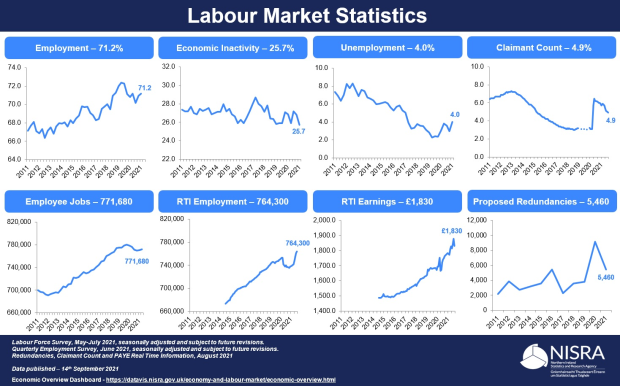Labour Market Report September 2021
Date published:
Latest labour market statistics published
The labour market statistics were published today by the Northern Ireland Statistics & Research Agency. Labour market indicators continue to show improvements over the short-term, with increases in the employment rate, number of employee jobs and payrolled employees over the quarter.
 August’s proposed redundancies lowest since April
August’s proposed redundancies lowest since April

- 80 redundancies were proposed during August 2021, taking the total number of proposed collective redundancies in the last twelve months to 5,460, 40% less than the number recorded in the previous twelve months (9,160).
- During August 2021, 130 redundancies were confirmed, taking the annual total to 5,060. This annual total was 31% higher than in the previous year (3,880).
NI Claimant Count (Experimental Series) decreased for the sixth consecutive month
- In August 2021, the seasonally adjusted number of people on the claimant count was 48,500 (4.9% of the workforce), which is a decrease of 1,000 (1.9%) from the previous month’s revised figure. The August claimant count is 24% below the recent peak in May 2020, and 59% higher than the pre-pandemic count in March 2020.
Payrolled employees now higher than pre-COVID for the third consecutive month
- The number of employees receiving pay through HMRC PAYE in NI in August 2021 was 764,300, an increase of 0.5% over the month and 3.7% over the year. This is the highest on record and the third consecutive month that employee numbers were above pre-COVID levels.
- Earnings from the HMRC PAYE indicated that NI employees had a median monthly pay of £1,830 in August 2021, a decrease of £48 (2.6%) over the month and an increase of £81 (4.6%) over the year.
The unemployment rate increased over the quarter and over the year
- The latest NI seasonally adjusted unemployment rate (the proportion of economically active people aged 16+ who were unemployed) for the period May-July 2021 was estimated from the Labour Force Survey at 4.0%. The unemployment rate increased by 1.0 percentage points (pps) over the quarter and increased by 1.0pps over the year. The quarterly change was statistically significant and likely to reflect real change.
- The proportion of people aged 16 to 64 in work (the employment rate) increased over the quarter by 0.2pps and over the year by 0.3pps to 71.2%. Neither the quarterly nor annual changes were statistically significant.
- The economic inactivity rate (the proportion of people aged 16 to 64 who were not working and not seeking or available to work) decreased over the quarter by 1.1pps and over the year by 1.1pps to 25.7%. Neither the quarterly nor annual changes were statistically significant.
Employee jobs increased over the quarter but decreased over the year
- Following four consecutive quarters of decline in employee jobs between March 2020 and December 2020, there have been marginal increases in employee jobs in March 2021 and June 2021.
- The number of employee jobs in June 2021 was estimated at 771,680. This was an increase of 1,190 jobs (+0.2%) over the quarter and a decrease of 4,860 jobs (-0.6%) over the year. Neither the quarterly nor the annual changes in employee jobs were found to be statistically significant.
- Quarterly increases in employee jobs were seen within the services (+1,360 jobs), manufacturing (+310 jobs) and other industries (+40 jobs) sectors to June 2021. The construction sector reported a decrease over the quarter (-520 jobs).
- All four broad industry sectors experienced decreases in employee jobs over the year to June 2021, with the services sector reporting the biggest annual decline (-2,910 jobs).
- Private sector jobs increased marginally over the quarter (+0.1% or +740 jobs) but decreased over the year (-1.1% or -6,310 jobs) to 556,820 jobs in June 2021. Public sector jobs increased over both the quarter (+0.3%, or +580 jobs) and the year (+0.6%, or +1,250 jobs) to 214,710 jobs in June 2021.
The statistical bulletin and associated tables are available on the Labour Market Report - September 2021 page.